light Alfa Romeo Brera/Spider 2007 Owner handbook (in English)
[x] Cancel search | Manufacturer: ALFA ROMEO, Model Year: 2007, Model line: Brera/Spider, Model: Alfa Romeo Brera/Spider 2007Pages: 271, PDF Size: 6.04 MB
Page 147 of 271

145
SAFETY
DEVICES
WARNING
LIGHTS AND
MESSAGES
IN AN
EMERGENCY
CAR
MAINTENANCE
TECHNICAL
SPECIFICATIONS
INDEX
DASHBOARD
AND
CONTROLS
CORRECT USE
OF THE CAR
Climate control
The air conditioner is an additional load
which greatly affects the engine leading
to higher consumption. When the tem-
perature outside the car permits it, use
the air vents where possible.
Spoilers
The use of aerodynamic optional extras
which are not certified for the specific
use on the vehicle, may reduce the aero-
dynamic penetration of the vehicle and
increase consumption. Unnecessary loads
Do not travel with too much luggage
stowed in the boot. The weight of the
car (especially when driving in town)
and its trim greatly affects consumption
and stability.
Roof rack/ski rack
Remove the roof rack or the ski rack
from the roof as soon as they are no
longer used. These accessories lower air
penetration and adversely affect con-
sumption levels. When needing to car-
ry particularly voluminous objects, prefer-
ably use a trailer.
Electric devices
Use electric devices only for the amount
of time needed. Rear heated window,
additional headlights, windscreen wipers
and heater fan need a considerable
amount of energy therefore, increasing
the requirement of current increases fu-
el consumption (up to +25% in the ur-
ban cycle).CONTAINING
RUNNING COSTS
Here are some suggestions which may
help you to keep the running costs of
your car down and lower the amount of
toxic emissions released into the at-
mosphere.
GENERAL CONSIDERATIONS
Car maintenance
Have checks and adjustments carried out
in accordance with the “Service sched-
ule”.
Tyres
Check the pressure of the tyres routine-
ly at an interval of no more than 4
weeks: if the pressure is too low, con-
sumption levels increase as resistance
to rolling is higher.
Page 148 of 271
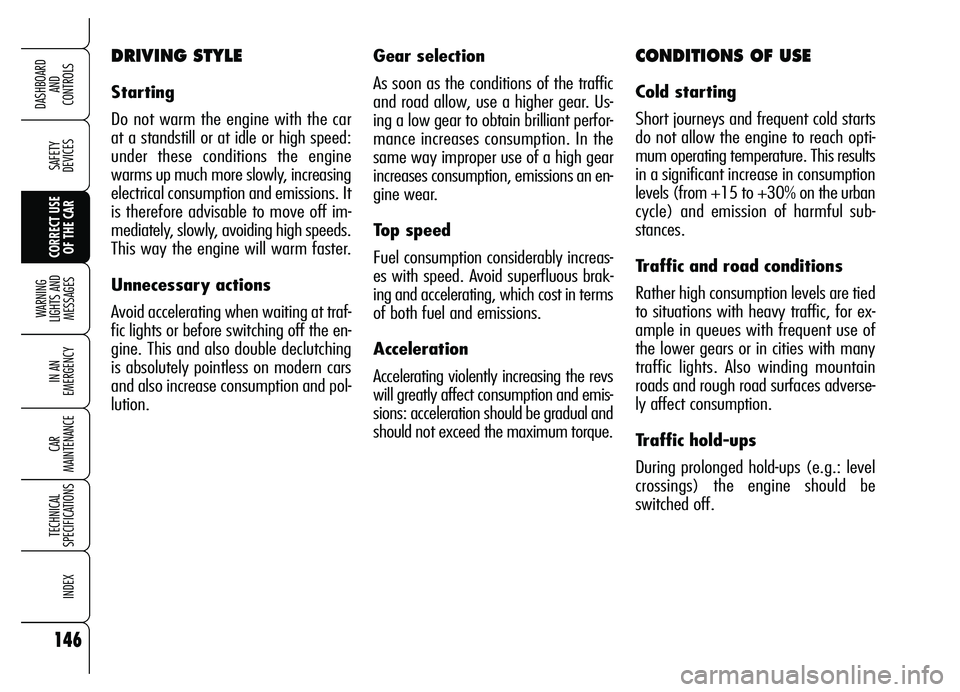
146
SAFETY
DEVICES
WARNING
LIGHTS AND
MESSAGES
IN AN
EMERGENCY
CAR
MAINTENANCE
TECHNICAL
SPECIFICATIONS
INDEX
DASHBOARD
AND
CONTROLS
CORRECT USE
OF THE CAR
Gear selection
As soon as the conditions of the traffic
and road allow, use a higher gear. Us-
ing a low gear to obtain brilliant perfor-
mance increases consumption. In the
same way improper use of a high gear
increases consumption, emissions an en-
gine wear.
Top speed
Fuel consumption considerably increas-
es with speed. Avoid superfluous brak-
ing and accelerating, which cost in terms
of both fuel and emissions.
Acceleration
Accelerating violently increasing the revs
will greatly affect consumption and emis-
sions: acceleration should be gradual and
should not exceed the maximum torque.CONDITIONS OF USE
Cold starting
Short journeys and frequent cold starts
do not allow the engine to reach opti-
mum operating temperature. This results
in a significant increase in consumption
levels (from +15 to +30% on the urban
cycle) and emission of harmful sub-
stances.
Traffic and road conditions
Rather high consumption levels are tied
to situations with heavy traffic, for ex-
ample in queues with frequent use of
the lower gears or in cities with many
traffic lights. Also winding mountain
roads and rough road surfaces adverse-
ly affect consumption.
Traffic hold-ups
During prolonged hold-ups (e.g.: level
crossings) the engine should be
switched off.
DRIVING STYLE
Starting
Do not warm the engine with the car
at a standstill or at idle or high speed:
under these conditions the engine
warms up much more slowly, increasing
electrical consumption and emissions. It
is therefore advisable to move off im-
mediately, slowly, avoiding high speeds.
This way the engine will warm faster.
Unnecessary actions
Avoid accelerating when waiting at traf-
fic lights or before switching off the en-
gine. This and also double declutching
is absolutely pointless on modern cars
and also increase consumption and pol-
lution.
Page 149 of 271
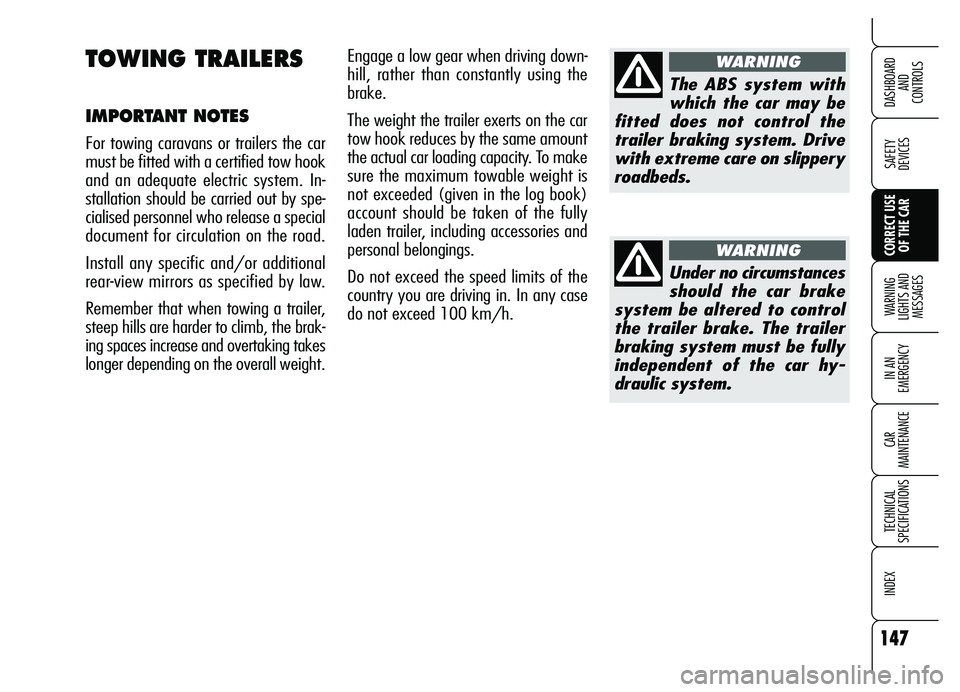
147
SAFETY
DEVICES
WARNING
LIGHTS AND
MESSAGES
IN AN
EMERGENCY
CAR
MAINTENANCE
TECHNICAL
SPECIFICATIONS
INDEX
DASHBOARD
AND
CONTROLS
CORRECT USE
OF THE CAR
Engage a low gear when driving down-
hill, rather than constantly using the
brake.
The weight the trailer exerts on the car
tow hook reduces by the same amount
the actual car loading capacity. To make
sure the maximum towable weight is
not exceeded (given in the log book)
account should be taken of the fully
laden trailer, including accessories and
personal belongings.
Do not exceed the speed limits of the
country you are driving in. In any case
do not exceed 100 km/h.TOWING TRAILERS
IMPORTANT NOTES
For towing caravans or trailers the car
must be fitted with a certified tow hook
and an adequate electric system. In-
stallation should be carried out by spe-
cialised personnel who release a special
document for circulation on the road.
Install any specific and/or additional
rear-view mirrors as specified by law.
Remember that when towing a trailer,
steep hills are harder to climb, the brak-
ing spaces increase and overtaking takes
longer depending on the overall weight.
The ABS system with
which the car may be
fitted does not control the
trailer braking system. Drive
with extreme care on slippery
roadbeds.
WARNING
Under no circumstances
should the car brake
system be altered to control
the trailer brake. The trailer
braking system must be fully
independent of the car hy-
draulic system.
WARNING
Page 150 of 271
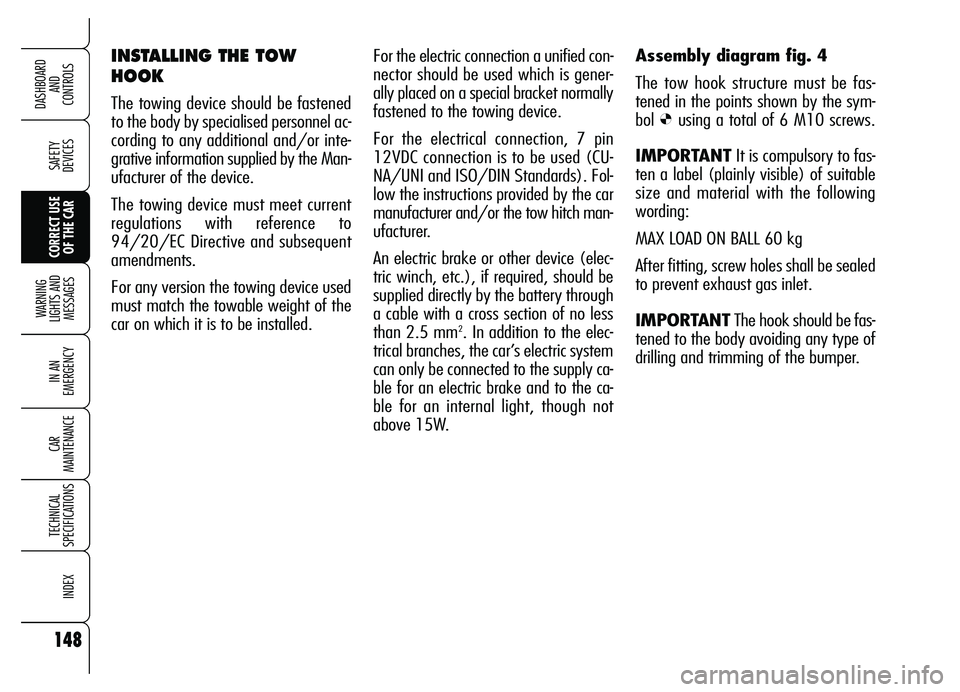
148
SAFETY
DEVICES
WARNING
LIGHTS AND
MESSAGES
IN AN
EMERGENCY
CAR
MAINTENANCE
TECHNICAL
SPECIFICATIONS
INDEX
DASHBOARD
AND
CONTROLS
CORRECT USE
OF THE CAR
For the electric connection a unified con-
nector should be used which is gener-
ally placed on a special bracket normally
fastened to the towing device.
For the electrical connection, 7 pin
12VDC connection is to be used (CU-
NA/UNI and ISO/DIN Standards). Fol-
low the instructions provided by the car
manufacturer and/or the tow hitch man-
ufacturer.
An electric brake or other device (elec-
tric winch, etc.), if required, should be
supplied directly by the battery through
a cable with a cross section of no less
than 2.5 mm
2. In addition to the elec-
trical branches, the car’s electric system
can only be connected to the supply ca-
ble for an electric brake and to the ca-
ble for an internal light, though not
above 15W.Assembly diagram fig. 4
The tow hook structure must be fas-
tened in the points shown by the sym-
bol
Øusing a total of 6 M10 screws.
IMPORTANTIt is compulsory to fas-
ten a label (plainly visible) of suitable
size and material with the following
wording:
MAX LOAD ON BALL 60 kg
After fitting, screw holes shall be sealed
to prevent exhaust gas inlet.
IMPORTANTThe hook should be fas-
tened to the body avoiding any type of
drilling and trimming of the bumper.
INSTALLING THE TOW
HOOK
The towing device should be fastened
to the body by specialised personnel ac-
cording to any additional and/or inte-
grative information supplied by the Man-
ufacturer of the device.
The towing device must meet current
regulations with reference to
94/20/EC Directive and subsequent
amendments.
For any version the towing device used
must match the towable weight of the
car on which it is to be installed.
Page 151 of 271

149
SAFETY
DEVICES
WARNING
LIGHTS AND
MESSAGES
IN AN
EMERGENCY
CAR
MAINTENANCE
TECHNICAL
SPECIFICATIONS
INDEX
DASHBOARD
AND
CONTROLS
CORRECT USE
OF THE CAR
fig. 4A0F0009m
REAR AXLE
Existing M10 screw
Existing M10 screw
Existing M10 nut Existing M10 nut
Standard tow ball
Full load
Page 152 of 271
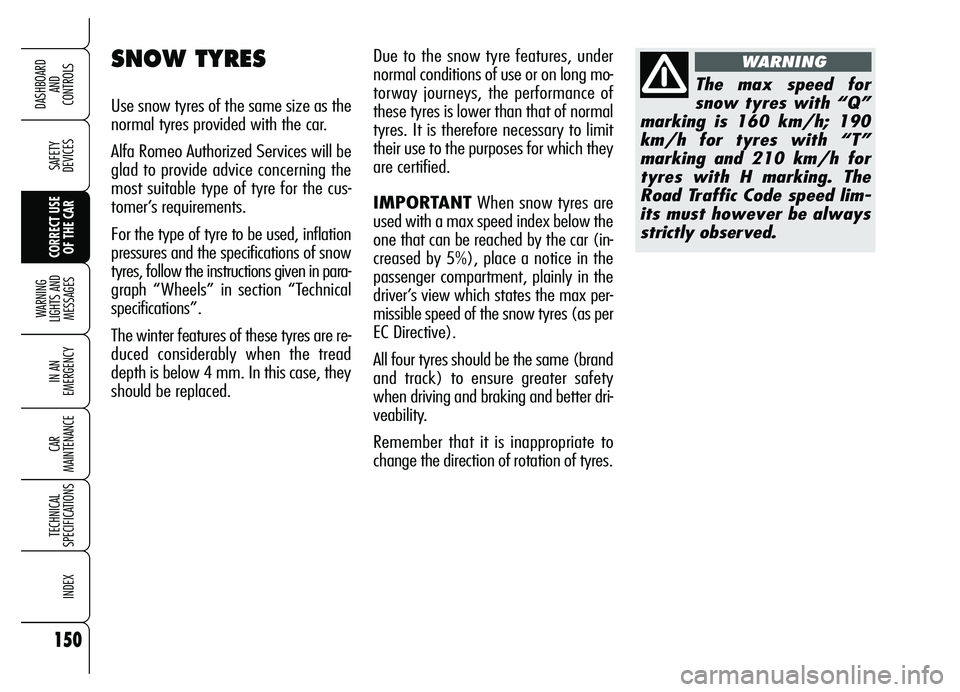
150
SAFETY
DEVICES
WARNING
LIGHTS AND
MESSAGES
IN AN
EMERGENCY
CAR
MAINTENANCE
TECHNICAL
SPECIFICATIONS
INDEX
DASHBOARD
AND
CONTROLS
CORRECT USE
OF THE CAR
Due to the snow tyre features, under
normal conditions of use or on long mo-
torway journeys, the performance of
these tyres is lower than that of normal
tyres. It is therefore necessary to limit
their use to the purposes for which they
are certified.
IMPORTANTWhen snow tyres are
used with a max speed index below the
one that can be reached by the car (in-
creased by 5%), place a notice in the
passenger compartment, plainly in the
driver’s view which states the max per-
missible speed of the snow tyres (as per
EC Directive).
All four tyres should be the same (brand
and track) to ensure greater safety
when driving and braking and better dri-
veability.
Remember that it is inappropriate to
change the direction of rotation of tyres.SNOW TYRES
Use snow tyres of the same size as the
normal tyres provided with the car.
Alfa Romeo Authorized Services will be
glad to provide advice concerning the
most suitable type of tyre for the cus-
tomer’s requirements.
For the type of tyre to be used, inflation
pressures and the specifications of snow
tyres, follow the instructions given in para-
graph “Wheels” in section “Technical
specifications”.
The winter features of these tyres are re-
duced considerably when the tread
depth is below 4 mm. In this case, they
should be replaced.
The max speed for
snow tyres with “Q”
marking is 160 km/h; 190
km/h for tyres with “T”
marking and 210 km/h for
tyres with H marking. The
Road Traffic Code speed lim-
its must however be always
strictly observed.
WARNING
Page 153 of 271
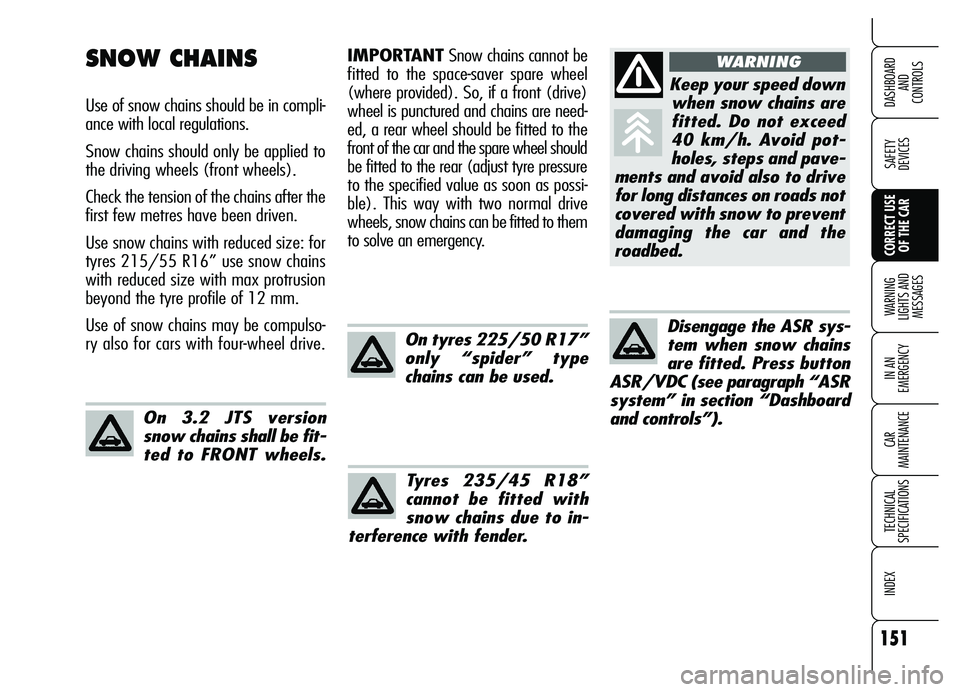
151
SAFETY
DEVICES
WARNING
LIGHTS AND
MESSAGES
IN AN
EMERGENCY
CAR
MAINTENANCE
TECHNICAL
SPECIFICATIONS
INDEX
DASHBOARD
AND
CONTROLS
CORRECT USE
OF THE CAR
IMPORTANTSnow chains cannot be
fitted to the space-saver spare wheel
(where provided). So, if a front (drive)
wheel is punctured and chains are need-
ed, a rear wheel should be fitted to the
front of the car and the spare wheel should
be fitted to the rear (adjust tyre pressure
to the specified value as soon as possi-
ble). This way with two normal drive
wheels, snow chains can be fitted to them
to solve an emergency.SNOW CHAINS
Use of snow chains should be in compli-
ance with local regulations.
Snow chains should only be applied to
the driving wheels (front wheels).
Check the tension of the chains after the
first few metres have been driven.
Use snow chains with reduced size: for
tyres 215/55 R16” use snow chains
with reduced size with max protrusion
beyond the tyre profile of 12 mm.
Use of snow chains may be compulso-
ry also for cars with four-wheel drive.
On tyres 225/50 R17”
only “spider” type
chains can be used.
Keep your speed down
when snow chains are
fitted. Do not exceed
40 km/h. Avoid pot-
holes, steps and pave-
ments and avoid also to drive
for long distances on roads not
covered with snow to prevent
damaging the car and the
roadbed.
WARNING
Disengage the ASR sys-
tem when snow chains
are fitted. Press button
ASR/VDC (see paragraph “ASR
system” in section “Dashboard
and controls”).
Tyres 235/45 R18”
cannot be fitted with
snow chains due to in-
terference with fender. On 3.2 JTS version
snow chains shall be fit-
ted to FRONT wheels.
Page 154 of 271
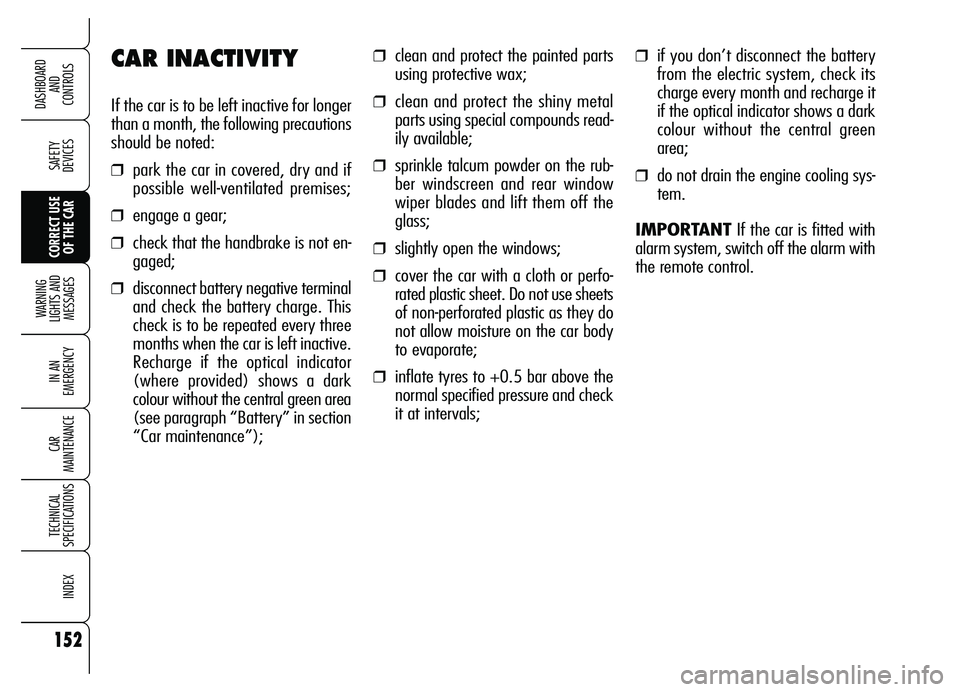
152
SAFETY
DEVICES
WARNING
LIGHTS AND
MESSAGES
IN AN
EMERGENCY
CAR
MAINTENANCE
TECHNICAL
SPECIFICATIONS
INDEX
DASHBOARD
AND
CONTROLS
CORRECT USE
OF THE CAR
CAR INACTIVITY
If the car is to be left inactive for longer
than a month, the following precautions
should be noted:
❒park the car in covered, dry and if
possible well-ventilated premises;
❒engage a gear;
❒check that the handbrake is not en-
gaged;
❒disconnect battery negative terminal
and check the battery charge. This
check is to be repeated every three
months when the car is left inactive.
Recharge if the optical indicator
(where provided) shows a dark
colour without the central green area
(see paragraph “Battery” in section
“Car maintenance”);
❒clean and protect the painted parts
using protective wax;
❒clean and protect the shiny metal
parts using special compounds read-
ily available;
❒sprinkle talcum powder on the rub-
ber windscreen and rear window
wiper blades and lift them off the
glass;
❒slightly open the windows;
❒cover the car with a cloth or perfo-
rated plastic sheet. Do not use sheets
of non-perforated plastic as they do
not allow moisture on the car body
to evaporate;
❒inflate tyres to +0.5 bar above the
normal specified pressure and check
it at intervals;
❒if you don’t disconnect the battery
from the electric system, check its
charge every month and recharge it
if the optical indicator shows a dark
colour without the central green
area;
❒do not drain the engine cooling sys-
tem.
IMPORTANTIf the car is fitted with
alarm system, switch off the alarm with
the remote control.
Page 155 of 271
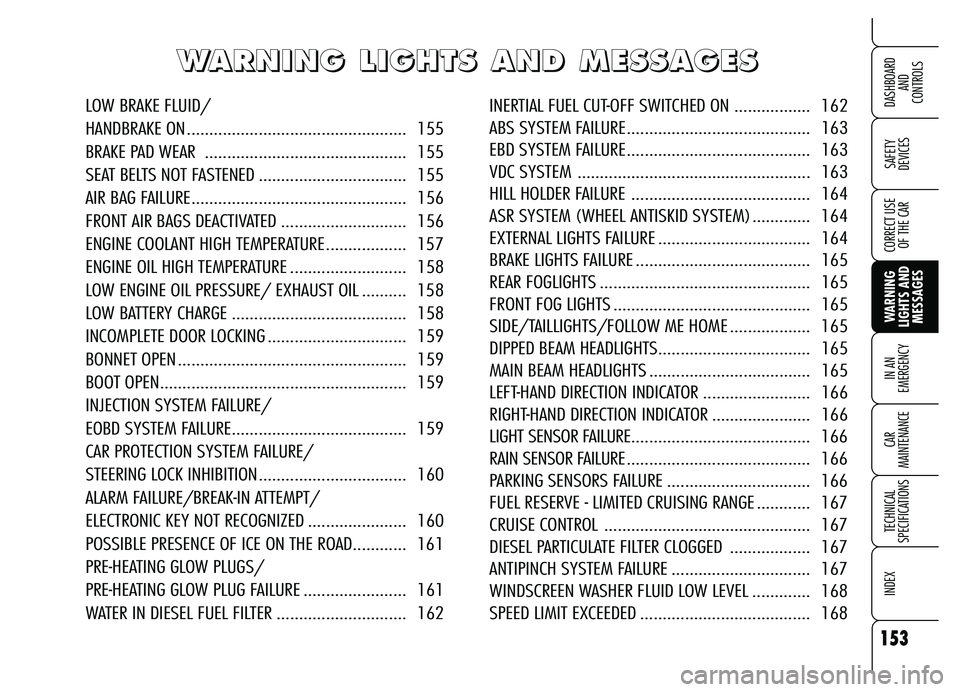
153
SAFETY
DEVICES
WARNING
LIGHTS AND
MESSAGES IN AN
EMERGENCY
CAR
MAINTENANCE
TECHNICAL
SPECIFICATIONS
INDEX
DASHBOARD
AND
CONTROLS
CORRECT USE
OF THE CAR
W W W W
A A A A
R R R R
N N N N
I I I I
N N N N
G G G G
L L L L
I I I I
G G G G
H H H H
T T T T
S S S S
A A A A
N N N N
D D D D
M M M M
E E E E
S S S S
S S S S
A A A A
G G G G
E E E E
S S S S
LOW BRAKE FLUID/
HANDBRAKE ON ................................................. 155
BRAKE PAD WEAR ............................................. 155
SEAT BELTS NOT FASTENED ................................. 155
AIR BAG FAILURE................................................ 156
FRONT AIR BAGS DEACTIVATED ............................ 156
ENGINE COOLANT HIGH TEMPERATURE.................. 157
ENGINE OIL HIGH TEMPERATURE .......................... 158
LOW ENGINE OIL PRESSURE/ EXHAUST OIL .......... 158
LOW BATTERY CHARGE ....................................... 158
INCOMPLETE DOOR LOCKING ............................... 159
BONNET OPEN ................................................... 159
BOOT OPEN....................................................... 159
INJECTION SYSTEM FAILURE/
EOBD SYSTEM FAILURE....................................... 159
CAR PROTECTION SYSTEM FAILURE/
STEERING LOCK INHIBITION................................. 160
ALARM FAILURE/BREAK-IN ATTEMPT/
ELECTRONIC KEY NOT RECOGNIZED ...................... 160
POSSIBLE PRESENCE OF ICE ON THE ROAD............ 161
PRE-HEATING GLOW PLUGS/
PRE-HEATING GLOW PLUG FAILURE ....................... 161
WATER IN DIESEL FUEL FILTER ............................. 162INERTIAL FUEL CUT-OFF SWITCHED ON ................. 162
ABS SYSTEM FAILURE......................................... 163
EBD SYSTEM FAILURE......................................... 163
VDC SYSTEM .................................................... 163
HILL HOLDER FAILURE ........................................ 164
ASR SYSTEM (WHEEL ANTISKID SYSTEM) ............. 164
EXTERNAL LIGHTS FAILURE .................................. 164
BRAKE LIGHTS FAILURE ....................................... 165
REAR FOGLIGHTS ............................................... 165
FRONT FOG LIGHTS ............................................ 165
SIDE/TAILLIGHTS/FOLLOW ME HOME .................. 165
DIPPED BEAM HEADLIGHTS.................................. 165
MAIN BEAM HEADLIGHTS .................................... 165
LEFT-HAND DIRECTION INDICATOR ........................ 166
RIGHT-HAND DIRECTION INDICATOR ...................... 166
LIGHT SENSOR FAILURE........................................ 166
RAIN SENSOR FAILURE......................................... 166
PARKING SENSORS FAILURE ................................ 166
FUEL RESERVE - LIMITED CRUISING RANGE ............ 167
CRUISE CONTROL .............................................. 167
DIESEL PARTICULATE FILTER CLOGGED .................. 167
ANTIPINCH SYSTEM FAILURE ............................... 167
WINDSCREEN WASHER FLUID LOW LEVEL ............. 168
SPEED LIMIT EXCEEDED ...................................... 168
Page 156 of 271
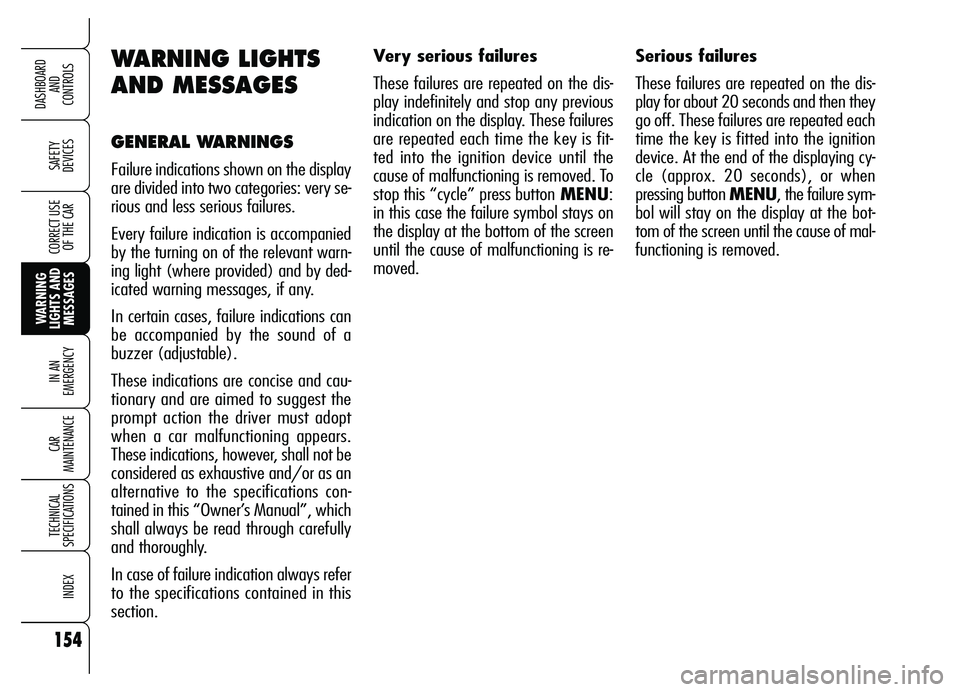
154
SAFETY
DEVICES
WARNING
LIGHTS AND
MESSAGES IN AN
EMERGENCY
CAR
MAINTENANCE
TECHNICAL
SPECIFICATIONS
INDEX
DASHBOARD
AND
CONTROLS
CORRECT USE
OF THE CAR
Very serious failures
These failures are repeated on the dis-
play indefinitely and stop any previous
indication on the display. These failures
are repeated each time the key is fit-
ted into the ignition device until the
cause of malfunctioning is removed. To
stop this “cycle” press buttonMENU:
in this case the failure symbol stays on
the display at the bottom of the screen
until the cause of malfunctioning is re-
moved.WARNING LIGHTS
AND MESSAGES
GENERAL WARNINGS
Failure indications shown on the display
are divided into two categories: very se-
rious and less serious failures.
Every failure indication is accompanied
by the turning on of the relevant warn-
ing light (where provided) and by ded-
icated warning messages, if any.
In certain cases, failure indications can
be accompanied by the sound of a
buzzer (adjustable).
These indications are concise and cau-
tionary and are aimed to suggest the
prompt action the driver must adopt
when a car malfunctioning appears.
These indications, however, shall not be
considered as exhaustive and/or as an
alternative to the specifications con-
tained in this “Owner’s Manual”, which
shall always be read through carefully
and thoroughly.
In case of failure indication always refer
to the specifications contained in this
section.Serious failures
These failures are repeated on the dis-
play for about 20 seconds and then they
go off. These failures are repeated each
time the key is fitted into the ignition
device. At the end of the displaying cy-
cle (approx. 20 seconds), or when
pressing button MENU, the failure sym-
bol will stay on the display at the bot-
tom of the screen until the cause of mal-
functioning is removed.